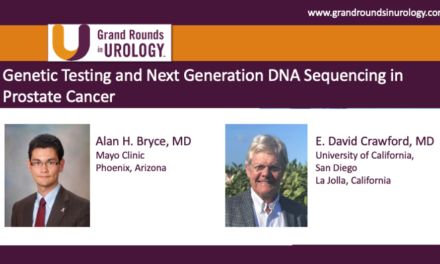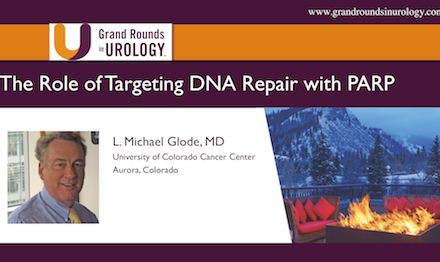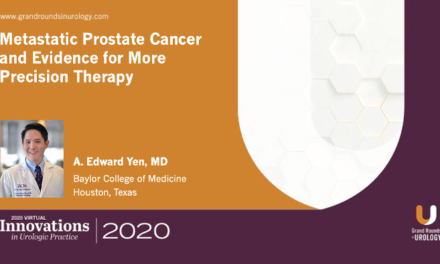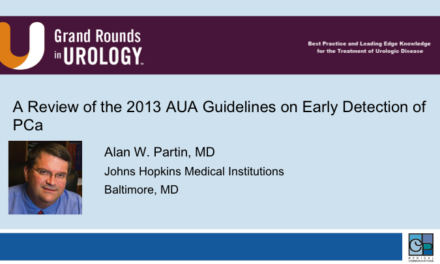Keywords: prostate cancer, biopsy, focal therapy, MRI
How to cite: Stone, Nelson N. “Prostate Biopsy and Targeted Therapy.” Grand Rounds in Urology. January 21, 2016. Jan 2025. https://dev.grandroundsinurology.com/prostate-cancer-nelson-n-stone-prostate-biopsy-and-targeted-therapy/.
Prostate Biopsy and Targeted Therapy – Edited Transcript
First question: Are you performing focal therapy?
I think that’s good. Most people are not doing it, and they shouldn’t be doing it based on current technology.
Next question: What percent of newly diagnosed prostate cancer patients do you believe would be candidates for focal therapy if they were correctly identified? This is the lead-in to the lecture.
Okay, so there’s not a lot of faith in focal therapy. Major disclosure: I’m President and CEO of 3DBiopsy.
Standard techniques: What we have today are our systematic 12-core biopsies. There are 1.2 million done per year in the U.S., 3.3 million done worldwide, and we do this by the MRI-guided technique, or we can do it by a transperineal technique. What you see in the literature mostly is template-guided, and now we’re starting to add a transperineal MRI co-registration.
One company’s selling it and I think the other companies will get onboard too, because there may be some advantages to doing this in the OR [operating room] rather than doing it in the office. Then we’ll speak about what my vision is, which is a 3D mapping-guided biopsy program.
This is how I see we should be managing prostate cancer today. At the first biopsy, the first TRUS biopsy, about maybe 15% of men or so… 10-15% of men are going to be diagnosed with high-grade disease right off the bat. They don’t need anything else other than surgery or radiation.
But the overwhelming majority of patients are going to be diagnosed with Gleason 6-7, and this is where our difficulty comes in, because most of these patients end up getting surgery or radiation, although we’re doing more surveillance today than we did in the past. Very few are getting focal therapy. But this is a total mish-mosh.
Patients are getting surgery that don’t need it: maybe as many as 30-50%. The same with RT [radiotherapy]. Patients are getting surveillance or focal therapy and they shouldn’t be getting it. They should be having surgery. We’re trying to develop new tools to help us distinguish who should have what, but unfortunately nothing is getting better than the 80%. Whether it’s a marker or whether it’s an MRI, we’re still left with at least 20% doubt as to whether or not we made the right decision.
This is a typical situation: We get a biopsy showing Gleason 6, and maybe you send that off for a GPS [Oncotype DX Genomic Prostate Score], thinking it’s low-risk. Well, what about these Gleason 7s in the anterior of the prostate where they missed? Will a genomic score down here actually reflect what’s going on up there? Will an MRI see these small, higher-grade lesions? This is one of the reasons why we can’t get better than the 80%.
This is a study I think is very well done: A French cooperative study of over 10,000 radical prostatectomies. 919 had strict criteria on the 12-core biopsy. They had to be T1C, they had to have a PSA less than 10, and they could only have one core positive with less than 3 mm of cancer, and Gleason 6 or less. Despite those strict criteria, only 26% of the 919 really had insignificant disease. So, this is telling you that if you relied on this information to put them into surveillance, or to put them into a focal therapy program, you’re probably wrong 3/4 of the time.
The playing field has really changed for us urologists and radiation oncologists. One, the ultrasound-guided biopsy was introduced. Cancers were larger and detectable by both DRE [digital rectal exam] and TRUS [transrectal ultrasound-guided biopsy]. It was almost impossible to miss the cancers 20 years ago when we were doing TRUS-guided biopsy. Today, the lesions are very small. They’re located in regions that are not discoverable by DRE or by TRUS. This has resulted in the 12-core biopsy being a semi-blind procedure. Re-biopsy using the same technology doesn’t yield any better result.
The public got the message long before we did. This is a study showing the decreased incidence of screening. It actually didn’t start out here when the new guidelines came out; it started back here in 2007 and 2008. Our internist colleagues and our patients started to recognize they were having prostatectomies they really didn’t need.
This behavior predates what we have thought about in the last few years, and screening rates declined by 10% from 2005-2008, and then they declined even more rapidly once the Task Force started talking about it… by another 18%. So, as a specialty, we’re behind the curve. Our patients are perhaps wiser than we are in deciding not to get screening done because of what it leads to.
When the CMS came out with this idea that maybe they’re going to make the urologists responsible if he or she orders a PSA, I wrote a fairly nasty article to The Wall Street Journal, which they published – I was kind of surprised – in December this year. Basically what I said in short was that the U.S. Preventative Task Force Services states that PSA causes more harm than good. The quote is “an unfortunate by-product of the success of PSA.” That’s the reality.
However, the problem isn’t PSA, but the biopsy technique used to diagnose prostate cancer. The solution to this problem is to improve the biopsy test, but that’s my opinion. If you have a test that shows something abnormal and you stick a needle in it and you’ve got your answer and you’re correct 100% of the time, nobody will be questioning what we’re doing.
So, biopsy approaches: You can do an MRI, but that’s only going to identify, for the most part, the index lesion. Some people believe that’s all you need to identify, and that’s going to result most likely in a hemi-ablation, whereas when you do a transperineal biopsy, you’re actually going to find the individual lesions, which gives you the potential to just ablate the lesion itself and not ablate a quarter or a half of the prostate.
This is a recent article from Mark Emberton’s group, by Ahmed, where they started to use targeted biopsies as the decision point to find a lesion to do focal therapy. You can see when they do focal therapy, it’s half the gland, or it’s a quarter of the gland, and in this short, small study with short follow-up – it’s about a year – they found that they eradicated the cancers 57% of the time, so in other words, a 43% local failure rate.
That’s not going to be acceptable in terms of a focal therapy, and that’s maybe why we got that answer, that most people wouldn’t want to do focal therapy, which I think is correct.
Here’s another problem; here’s an MRI study. What the study looked at was the ability to measure the size of a lesion on an MRI and correlate that to the radical prostatectomy specimen, so the idea here is you find a lesion on MRI, you decide to target it. How big does the targeted zone need to be?
What they found, and this is the correlation between the two, is that underestimation occurred in 49% of the patients by a mean of 0.56 cc, which is a pretty large size, but the range is up at 2.8 cc. So, with data like that, I would not be suggesting that we should be using the MRI to do focal therapy.
So, what about the transperineal technique? This is a colleague of mine from Greece. He’s doing a transperineal biopsy. You can see he’s working at the perineum, going through a grid. You can see the needle going in the prostate here in sagittal imaging. This is technique that’s not new; I’ve been doing it at Mount Sinai for 10 years, Dave Crawford’s been doing it here in Colorado for 10 years, and many other people have been doing it for as long, if not longer. Winston Barzell was the first one to describe this more than 10 years ago.
The problem is that it takes a long time to do this thing, because you’re using a short needle and you’re biopsying the longitudinal aspect of the prostate, so nobody wants to spend all day doing that. In fact, I’ve been in the OR with Dave watching him do cases, and he’s tackling a 50 g prostate and he’s taking at least two cores per cc, so he’s taking over 100 biopsies in that patient. Two hours has gone by, and it’s like, this is crazy.
People have tried to come up with all different techniques. Here’s a few strategies: Just biopsy the anterior, biopsy half the anterior or the posterior on the left side, on the right side, trying to cut down. It’s 24 biopsies regardless of prostate size, which is a mistake. When you look down here, remember the negative predictive value? Again, it’s in the 80% range. To me, that’s pretty useless, to do a strategy like this.
We have a couple papers out at the AUA [American Urological Association] on the mapping. Dr. Crawford does it differently. He biopsies the entire prostate, that why he’s taking so many specimens. Dr. Skouteris has got another paper; he’s a colleague of mine that I trained at Mount Sinai.
So, we combined the data from these two centers, and one of the papers was looking at the ability of transperineal mapping to predict whether or not a patient should have a prostatectomy. There were 25 patients who had studies after the mapping. 23 of them had high-volume disease on the mapping biopsy, they had high-volume disease on the radical.
Two patients of the 25 had just one or two cores positive, Gleason 6 on the mapping. They insisted on having radicals. They had one or two small spots of Gleason 6 on the radical. In this case, the mapping biopsy predicted the radical prostatectomy need correct 100% of the time.
The second paper was on infections. We compared mapping to the TRUS biopsy, so as you would expect with the TRUS biopsy, the infection rate was five times higher. The trade-off was that you had a urinary retention rate of 7.4% with a mapping biopsy versus none with the TRUS biopsy. The retention was associated with older age and larger prostate size.
Like I said, no one’s going to spend two hours taking biopsies in the OR. It doesn’t pay, it’s ridiculous, so less than 5% of biopsies are done transperineally. Can we change that? In 2012, I retired from clinical practice at Mount Sinai and moved out here, and I said, okay, what am I going to do all the time now? Ski and bike? That’s fun. So, I decided I needed a new career, which was to start the medical device company.
The reason I started it was because I wanted to take on the challenge, which was can we find a better way to biopsy the prostate and reverse this terrible trend we’re now facing? I looked at the problems. So, the problems were, we’re using a needle that was designed for TRUS biopsies 30 years ago. Why would anybody use that for a transperineal biopsy when you’re trying to take a biopsy from apex to base in one shot? So that’s got to go.
If you’re taking biopsies transperineally and you want to record the site from where the biopsy was in case it’s positive and you want to come back at a later date and just ablate that one region, you need software to do that. That didn’t exist.
What are you going to do with the specimen when you’re done? So, typically we take a biopsy, we put it on a piece of – – , we stick it in the formaldehyde, it goes to the lab, it’s in four or five pieces. Who cares? We only care about cancer on the specimen.
But now we want to send this pathologist a piece of spaghetti 5 cm long, and if it falls apart, he can’t look from base to apex and tell us where that cancer is, so we’re not going to be able to use that information for focal therapy, because there’s going to be back-up loaded to the software.
All of the problems need to be solved, not one. So, four different problems. We went to work on that. The first thing with the software was, if you assume that you could take biopsies – this comes from an article by Kepner – if you could take biopsies every 5 mm through a grid point, 5 mm from the apex – I mean, sorry, 5 mm from the capsule – 5 mm from the urethra, and 5 mm apart, and you use a 15 gauge needle, you could get a probability curve, and if you set the detection rate at a radius of 2.5 mm, then the probability of finding that tumor is 97%.
In theory, you could find basically every cancer in the prostate that’s 2.5 mm or larger in size. That’s the theory behind putting together the software. We did that, we built a program, where you’re in the OR using trans or regular ultrasound, and you’re contouring the prostate from base to apex. It’s very similar to what I did with brachytherapy.
The biopsy program lays in a plan. Here’s a plan: yellow dots, all the circles are biopsy sites, 5 mm apart, and 5 mm from the margin of the prostate. This would be biopsy 1, 2, 3, 4, 5, et cetera. So, it was possible to write a software program. We did this two years ago. It’s been tested in two hospitals; it works very well.
The next problem is the needle. Remember, I said you can’t be using a 17 mm specimen core, so this is the old needle, and this is the new needle. It’s six sonometers long. Now, the problem with this needle is, if you’re taking a 3 sonometer biopsy, because that’s the distance from apex to base at that point in the prostate, you have to have 3 sonometers. So, you know with a standard 17 mm needle, when you use that, the average length of the biopsy is 12 mm. In other words, 40% of the specimen is missing.
But again, nobody cares, because you’re just giving tissue. But if we have a needle now and you’re supposed to take 4 sonometers and you get 3, you’re going to go, where’s the other sonometer from? Is it from the base, from the apex? So, that’s not going to work. What we developed were these little ridges in the back of the core bed of the needle. It turns out these ridges hold the specimen, so when we tested this needle, you actually get at 4 sonometers 96% retention rate for the specimen. So, that problem was solved.
Then the gun; you need a gun now that’s going to shoot the needle the distance required by the software, so we developed this prototype. Here’s a dial; it tells you how far the needle will shoot. So, if you want 3 sonometers you’ll dial it to 3 sonometers. There is a counter here, so if you’re on biopsy 1, it says 1. If you’re going to the next biopsy, it says 2. Well, you think, why would you want to put that in the gun to keep track of it?
Well, when you’re down to the 25th biopsy and you’re a urologist and you’re working at lightning speed, and you’re handing it off to the nurse, she makes one mistake, she writes 21 instead of 20, and then that pathology you’re going to use for focal therapy? That’s not going to work. So, you have to have this all under control, which is why you have the counter there. When the software says 10, and you hand it to the nurse, it says 10; there’s no mistake.
The last thing was the most difficult, which was to figure out how to create a pathway for the pathologist to make it easy for them to read the specimen. Keeping in mind, with Medicare’s brilliance of making the G-code only for one specimen, whether it’s 1 or it’s 50, it doesn’t matter. So, we look at the workflow. We found here, in red, nine places we can streamline for the pathologist. That ended up resulting in the creation of this biopsy carrier concept.
You put the specimen on here and it folds over. So, this is the full 6 sonometers, it sticks to it, and then you have the numbers on the outside so they can access it. That goes in formaldehyde, this carrier – that’s what it looks like in real life. It’s a polyester woven fabric. This goes into formaldehyde, it then goes into the cassette, it gets embedded with wax, and then it goes on the microtome, so they never have to remove the specimen from the carrier.
So, when you’re left with the information – this patient, for example, one of Dr. Crawford’s patients, had one biopsy Gleason 6. Came in for a mapping biopsy with the software, and he ended up having five lesions with Gleason 6, which is kind of intriguing now. Not only does this patient have five lesions Gleason 6, he’s not one or two. What are you going to do with this patient?
This might be the type of patient where you take all five lesions, you batch them together, you send it off to genomic health. They tell you on all of the five lesions, not on one that you encounter, but all five, that the GPS score is low. That’s probably as close to 100% as you can get, and knowing that patient is correct for active surveillance.
Here’s another patient that had one core at Gleason 7 on his TRUS biopsy. He went through the mapping and he ended up with four cores Gleason 6, and four cores Gleason 7. This might be a patient you could actually do focal therapy on because you could do this area and you can do each of these three lesions.
So, now we have the ability to have a road map, because this information can be uploaded to any type of treatment-planning system, whether it be cryo, whether it be focal brachy, it really doesn’t matter. You just have access to the lesions. That shows you how the cassette sits in the lab and looks on the slide.
Selection of surveillance candidate can be improved with MRI, targeted biopsies, or transperineal biopsies. So, selection. Targeted focal therapy requires precise location of all significant lesions, and then a road map for treatment planning. The jury is out as to whether some or all lesions need to be treated, and that we’re going to need to answer in time.
Proof of success of lesion eradication remains elusive, because at the end of the day, just like I showed you in the Ahmed study, you have to prove that you’ve gotten rid of those cancers, because we’re not taking out the prostate. You can’t rely on PSA. So, that’s probably going to mean going back to the exact same site, whether it be six months or a year later, and prove the cancer’s gone, to know that we’re actually comfortable with the system.
ABOUT THE AUTHOR
Nelson N. Stone, MD, is Professor of Urology, Radiation Oncology, and Oncological Sciences at the Icahn School of Medicine at Mount Sinai and at the Derald H. Ruttenberg Cancer Center at Mount Sinai. He also serves as CEO of 3D Biopsy, LLC.
Dr. Stone earned his medical degree from the University of Maryland in 1979. He completed a Residency in General Surgery in 1981 at the University of Maryland, followed by a Residency in Urology at the University of Maryland. He then completed a Fellowship in Urologic Oncology at Memorial Sloan-Kettering Cancer Center and a Research Fellowship in Biochemical Endocrinology at Rockefeller University in 1986. He was Chief of Urology at Elmhurst Hospital from 1989-1996.
Dr. Stone has founded several medical companies and serves on the editorial board of many scientific journals. He is a member of many professional societies, including the Prostate Conditions Education Council, the Society for Minimally Invasive Therapy, the New York State Urological Society, the American Association of Clinical Urologists, and the American Urologic Association. Dr. Stone has participated in approximately 25 research studies on prostate cancer and has authored more than 400 articles, abstracts, and book chapters, primarily on prostate cancer. He invented the real-time technique for prostate seed implantation in 1990 and has trained more than 5,000 physicians worldwide on prostate brachytherapy through his company ProSeed. His company, 3DBiopsy, Inc., is developing variable length biopsy devices, mapping software, and an integrated pathology system.





